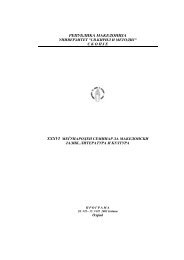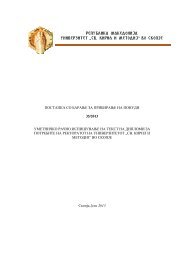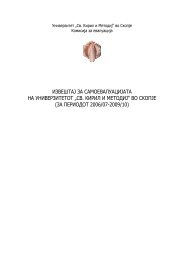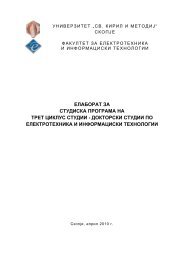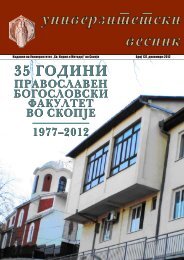УНИВЕРЗИТЕТ „СВ. КИРИЛ И МЕТОДИЈ“ – СКОПЈЕ
УНИВЕРЗИТЕТ „СВ. КИРИЛ И МЕТОДИЈ“ – СКОПЈЕ
УНИВЕРЗИТЕТ „СВ. КИРИЛ И МЕТОДИЈ“ – СКОПЈЕ
You also want an ePaper? Increase the reach of your titles
YUMPU automatically turns print PDFs into web optimized ePapers that Google loves.
158<br />
/dz/ This phoneme is always written with the graphemes , as for<br />
example, the word nádzat that is written νάτζατ. The affricate /dz/ is homographic<br />
with the affricate /c/.<br />
/i/ This phoneme is written with the graphemes and the digraphs<br />
. All these ways of writing are present in the manuscript and their use<br />
is controlled mainly by the Greek graphotactics. Of all the graphemes used to<br />
represent /i/, grapheme and the digraph are the least used. The use of<br />
is limited mainly to some isolated lexemes, but it occurs regularly in them.<br />
These lexemes include, for example, Σáν, Γοσποδύν, and σáλα (stdr. Mac. син,<br />
господин ja сила). At least in these words, the use of might be due to the<br />
fact, that their equivalents on the Greek side of the manuscript all include the<br />
letter υ: Υƒός Κύριος ja δύναμις (Lindstedt, personal communication).<br />
/j/ This phoneme is often written with an and a diaresis. is used<br />
mainly, when /j/ follows a vowel. For instance, the verb prikažúvaj appears as<br />
πρικαζγ΄ÿβαϊ. The same way of writing is used in Greek, when jota is pronounced<br />
separately from a digraph (εϊ, οϊ, αϊ).<br />
Word-initial /j/ is depicted in two ways. Sometimes it is written with a<br />
and a ligature conjoined to one of the following graphemes . It<br />
can also be written with a palatal arc under the vowel, before which the /j/ is<br />
intended. To exemplify these two usages are the two common ways to write<br />
the personal pronoun jáze: ι-¥ζε or ¥ÿζε.<br />
/k/ This phoneme is written with a . In addition, /k/ is written with<br />
the grapheme that depicts the two phonemes /ks/. The grapheme occurs<br />
only three times in the text.<br />
/l/ This phoneme is written with a .<br />
/l’/ This phoneme is written with a and a following grapheme <br />
conjoined with a ligature to one of the following graphemes , or, with a<br />
and a palatal arc below the following vowel. An example of these two ways<br />
of writing are the words puvél’a and nal’utí, written as πγβέλι-α and ναλγÿτί.<br />
/m/ This phoneme is written with a .<br />
/n/ This phoneme is written with a . Unlike a majority of the consonants,<br />
/n/ can occur doubled in the text. For example, in the verb panná (aorist,<br />
1. pers. sg.), the assimilation of [d] and [n] has produced a doubled /n/.<br />
/n’/ This phoneme is written with and the following grapheme <br />
conjoined with a ligature to one of the following graphemes . As an example,<br />
the word cvetín’ata is written as τζβετίνι-ατα. However, not all <strong>–</strong> <br />
<strong>–</strong> ligature sequences are unambigous, as the two forms of the following lexeme<br />
exemplify: γ΄μρένι-γτ and γ΄μρένιτε. If the first one is interpreted as umrén’ut,<br />
then the second should be equally umrén’ite. It is more likely that the writer<br />
has intended either the sequence /-ni-/, or /-nij-/.<br />
/o/ This phoneme is written either with an , or an . Both ways<br />
are present in the text, and the occurrences are often regulated by the Greek






